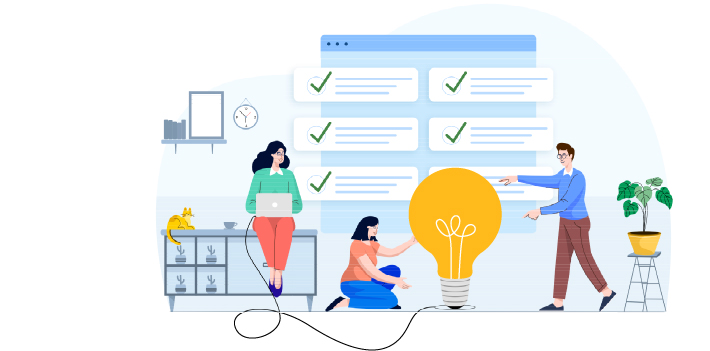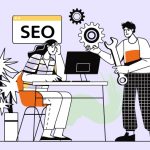Landing pages play a crucial role in the success of e-commerce businesses. They’re the pages where potential customers land after clicking on an ad, email link, or a search engine result. The goal of a landing page is simple yet powerful: to encourage visitors to take a specific action, such as buying a product or signing up for more information. These pages differ from your typical homepage because they’re tailored to match visitors’ expectations, providing them with precisely what they’re looking for without any distractions. By focusing on a single call to action and presenting information directly relevant to the visitors’ needs, landing pages are an effective way to turn casual browsers into committed buyers.
What Are Ecommerce Landing Pages?
Ecommerce landing pages are specialized web pages crafted to get visitors to take a specific action. Think of them as focused, persuasive pitches to your potential customers. These aren’t just any ordinary pages on your website; they are designed with one goal in mind: to convert visitors into customers or leads.
For example, if you run an online store, you might create a landing page to highlight a limited-time promotion or to feature a newly released product. The idea is to give visitors all the information they need about the offer and make it as easy as possible for them to decide and act on it—whether buying a product, signing up for more information, or downloading content like an ebook.
What sets ecommerce landing pages apart is their customization. They are carefully crafted to appeal to a specific segment of your market, meaning that the words, images, and calls to action are chosen to resonate with your target audience’s particular needs and wants.
Another critical aspect of ecommerce landing pages is their measurability. With the right tools, you can track just about everything, from the number of visitors to the time they spend on the page and, most importantly, their actions. This data is invaluable as it helps you understand what elements of your page are practical and what might need tweaking to improve performance.
In essence, ecommerce landing pages are powerful tools in your digital marketing arsenal. They are designed to maximize the impact of your promotional efforts and drive targeted actions that benefit your business.
Understanding Product Pages
Product pages are essential for any online store. They’re like individual showcases for each product you sell. When a customer clicks on a product, they’re taken to its product page, where they find everything they need to know: what it looks like from various angles, what it does, how much it costs, and the specifications that make it unique. The goal of a product page is to give enough compelling information to encourage the shopper to make a purchase. You’ll find the “Add to Cart” or “Buy Now” button, which is the final step before a customer proceeds to checkout.
Exploring Ecommerce Landing Pages
Ecommerce landing pages, on the other hand, have a different mission. Think of them as specialized tools for marketing campaigns. They’re crafted to target a specific audience or to promote a particular marketing initiative. For instance, if you’re having a sale or launching a new product line, you might create a landing page to highlight these events. The focus is on conversion – getting the visitor to take action, whether making a purchase, signing up for a newsletter, or taking advantage of a promotional offer.
Struggling with Digital marketing? Book Your Free Strategy Session!
- 30-Minutes Session
- Expert Insights
- Data-Driven approach
- Optimized Strategies for Your Goals
Select one of over 500 designs and establish your online presence.
- Free Web Hosting
- Fully Managed Solutions
- Scalable Websites
- No Hidden Cost
Landing pages are typically accessible from the usual website navigation. This design choice helps to limit distractions and guides the visitor toward the intended action without tempting them to click away. This focused environment is ideal for tracking how well the page converts visitors into customers or leads.
Design and Functionality Differences
While product pages are part of your site’s consistent design, landing pages can break away from this format. They might not have the usual headers or footers, and their layout is often more creative and persuasive. The idea is to create a compelling and immersive experience that tells a story or presents a deal too good to pass up.
The Role of Testing and Analytics
Another advantage of landing pages is their role in testing and analytics. Since they’re separate from the leading site, it’s easier to run A/B tests to see which designs, messages, or offers resonate best with your audience. This data is invaluable as it helps you understand your customers better and refine your marketing strategies for increased effectiveness.
In essence, while product and ecommerce landing pages may seem similar at first glance, they serve distinct purposes and are designed with different goals in mind. Product pages are the go-to for detailed product information, while landing pages are strategic tools that drive specific marketing outcomes.
Benefits of Landing Pages for Your Ecommerce Business
More ROI
Landing pages are powerful because they can boost your return on investment. They’re designed to grab visitors’ attention and guide them toward purchasing or signing up for something. This focused approach effectively gets more results from each visitor, meaning you could make more money from the same traffic.
Lead Generation
Think of landing pages as your digital salespeople who work 24/7. They’re great at starting conversations with potential customers. Visitors can share their contact details with you by offering a free download, discount code, or valuable information. Once you have those details, you can send them emails tailored to their interests, which can help turn them into loyal customers.
Higher Conversions
The whole point of landing pages is to get people to take action, whether buying a product or joining a mailing list. Every part of the page, from the words at the top to the button they click to submit their info, is designed to make that action happen. That’s why landing pages usually convert better than general product pages – they’re built with a single goal in mind and do everything to make that goal as achievable.
A/B Testing Opportunities
Landing pages are fantastic for experimenting with different marketing strategies through A/B testing. You can set up two versions of your landing page with some changes between them—maybe a different headline or a new button color—and then see which one gets better results. This testing is an intelligent way to ensure you’re constantly improving and making the most of your marketing efforts. It’s like having a constant feedback loop that tells you what works best for engaging your customers.
Customer Response and Engagement
When you use landing pages, you create a dedicated space for a single product or promotion. This focused approach makes tracking how people interact with your page much more straightforward. You can see how many people click the “buy” button, how long they spend reading your content, and what parts of the page they seem to focus on. This information is gold because it helps you understand what draws customers in and what might be turning them away.
Select one of over 500 designs and establish your online presence.
- Free Web Hosting
- Fully Managed Solutions
- Scalable Websites
- No Hidden Cost
Marketing Insights
The data you gather from landing pages is precious. Since these pages are all about one thing, it’s easier to see what’s working and what’s not. For example, you might discover that certain headlines get a lot more attention or that using a specific image leads to more people purchasing. These insights can guide you in tweaking your pages for better performance and influence other areas of your marketing strategy. It’s like having a cheat sheet that tells you how to win over your audience.
Grow Your Email List
Expanding your email list is crucial for building relationships with potential and current customers. An intelligent way to do this is by creating an engaging landing page. This is a standalone web page, distinct from your main website, designed with a single focused objective – to get visitors to sign up. You can entice people to subscribe by offering them something they find valuable. This could be a discount on their next purchase, access to exclusive content, or a helpful ebook. When visitors see they can get something beneficial in return for their email, they’re more likely to sign up.
Types of Landing Pages
Click-Through Landing Page
A click-through landing page serves a specific purpose: to warm up potential customers to your product or service and lead them closer to purchasing. It acts as a middleman between the advertisement that caught their attention and the checkout page or a registration form. The goal is to provide enough compelling information and benefits to motivate visitors to click through to the next stage of your sales funnel. A click-through page can effectively guide visitors to the next step in their buyer’s journey by removing distractions and focusing on the benefits.
Lead Generation or Squeeze Page
A lead generation or squeeze page is designed with a clear purpose: to gather contact details from visitors, such as email addresses. This landing page is beneficial for building a database of potential customers. To encourage people to share their information, these pages often provide a tempting offer, like a free e-book, a discount code, or access to exclusive content. The design is usually straightforward, with a form for visitors to fill out and minimal distractions. The success of these pages is measured by how many visitors convert into leads, making them a critical tool for online marketing campaigns.
Infomercial/Long-Form Landing Page
Think of an infomercial/long-form landing page as a deep dive into a product or service. These pages take a visitor through a journey, starting with highlighting a particular problem or need they might be experiencing. Then, they introduce the product or service as the perfect solution. The page will explain the benefits and features in detail, often using testimonials, comparisons, and demonstrations to build trust and persuade the visitor. Because of their length and detail, these pages are great for products or services that require a bit of education or are higher in price, as they give potential customers all the information they might need to make an informed decision.
Video Landing Page
Video landing pages harness the power of visual storytelling to engage visitors. By incorporating video content, these pages can quickly communicate a message or demonstrate a product in a way that is easy for visitors to digest and enjoy. Videos can range from testimonials and product demos to animated explainers and company introductions. They are especially effective because they can convey emotion and personality, making a brand more relatable and memorable. A well-produced video can keep visitors on the page longer, increasing the likelihood of them taking the desired action, such as purchasing or signing up for more information.
Microsites
Microsites are small websites centered around a product or a specific marketing campaign. They’re more comprehensive than a landing page, yet their purpose is clear and focused: to steer visitors toward one particular action, such as signing up for a newsletter or purchasing. Often, they’re used to highlight a new product launch, promote a special event, or target a particular audience segment with tailored content.
Tips for Creating the Best Ecommerce Landing Page
Simple Design is Key
When designing an ecommerce landing page, less is often more. A page crammed with too much information or too many images can confuse and overwhelm your visitors. Instead, opt for a streamlined design that draws attention to essential elements. A clear, compelling headline and a standout call-to-action (CTA) button are crucial. These components should grab the visitor’s attention and clarify what step they should take next.
Struggling with Digital marketing? Book Your Free Strategy Session!
- 30-Minutes Session
- Expert Insights
- Data-Driven approach
- Optimized Strategies for Your Goals
Avoid Site Navigation
On a typical website, navigation menus help users navigate. However, on a landing page, you want to keep your visitors laser-focused on one thing: conversion. Removing the navigation menu eliminates the chance of visitors wandering off to other parts of your site, which can distract them from completing the desired action. When there’s only one thing to do on a page, visitors are more likely to do it, leading to higher conversion rates for your business.
Use High-Quality Videos and Images
Visuals are crucial for making a solid first impression. Using high-quality images and videos on your landing page shows visitors that you value professionalism and attention to detail. This can significantly influence how potential customers perceive your brand. On the other hand, low-quality visuals may suggest a lack of care or professionalism, discouraging people from engaging with your content or buying your products. Always choose explicit, high-resolution media that aligns with your message and enhances the user’s experience.
Be Consistent with Paid Ad Campaigning Efforts
When someone clicks on an ad and lands on your page, they expect to see a continuation of the conversation that started with the ad they clicked on. If there’s a mismatch in the tone, style, or message, it can be not very clear. To avoid this, align your landing page closely with your paid advertising campaigns. Use similar language, colors, and imagery to seamlessly transition from the ad to a landing page. This reinforces your message and creates a more fluid experience for the user, which can lead to better conversion rates.
Use Your Brand Voice
Your landing page is an extension of your brand and should sound like it. Using your brand’s unique voice and tone can make your landing page more personal and relatable. It’s not just about what you say but how you say it. Are you friendly and casual, or formal and professional? Whatever your style, make sure it’s reflected in the copy on your landing page. This consistency in communication helps build trust with your audience. When visitors recognize and connect with your brand’s voice, they’re more likely to feel comfortable taking the next step, whether signing up for a newsletter or purchasing.
Tailor It to the Intended Sales Funnel
When creating a landing page, it’s essential to consider where your visitor might be in their buying journey. If they get to know your product or service, they’ll probably want a good amount of information before they feel comfortable moving forward. On the other hand, if they’ve been considering your offer for a while and are nearly ready to buy, they might need a final nudge or a bit more convincing. So, design your landing page with these needs in mind. For newcomers, ensure enough clear, helpful information without overwhelming them. For those further along, focus on reinforcing the value and simplifying the purchasing process.
Include Only One CTA
When you’re asking a visitor to take an action, it’s best to keep it simple. Choose one clear call to action (CTA) for your landing page. This could be ‘Sign Up,’ ‘Buy Now,’ or ‘Learn More,’ depending on what you want the visitor to do. Presenting multiple CTAs can be confusing and make it harder for visitors to decide what to do next. This can lead to them leaving your page without taking action. A single, well-defined CTA clarifies the next step and can help increase visitors’ chances of following through.
Take Care of the Mobile Optimization Aspect
These days, a lot of web traffic comes from mobile devices like smartphones and tablets. Your landing page must look good and work well on those smaller screens. This isn’t just about making sure the design adjusts to different screen sizes, which is part of responsive design, but also ensuring that the page loads quickly. People on mobile devices often have less patience for slow-loading pages, and if your page takes too long, they might give up and go somewhere else. So, test your landing page on different devices, check the load times, and adjust the design and features to ensure mobile users have a great experience.
Use Social Proof
Social proof, like customer testimonials or product reviews, is a powerful way to build trust with potential buyers. When people see that others have had positive experiences with your product or service, they’re more likely to feel confident in making a purchase themselves. Make sure to showcase genuine feedback from satisfied customers to reassure visitors that they are making the right choice.
Perform A/B Tests
A/B testing allows you to compare two web page versions to see which performs better. By making small changes to elements such as headlines, button colors, or images and testing these variations with your audience, you can discover which combination leads to more conversions. This trial-and-error process can significantly improve the effectiveness of your landing pages.
Final Thoughts
For anyone running an e-commerce store, investing in well-designed landing pages is essential. These pages are more than just a stop on the way to your website; they’re an opportunity to connect with your customers and show off what makes your products stand out. They allow you to create a personalized experience that speaks directly to your audience’s desires and needs. Plus, with landing pages, you can accurately track how well your marketing strategies are working. When you make your landing pages as compelling as possible, you set up your e-commerce business for better lead capture, higher conversion rates, and increased sales. It’s a wise investment that can significantly impact your online success.



